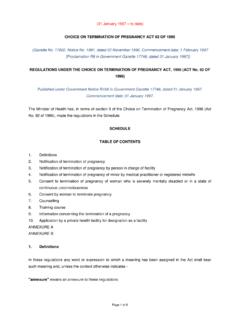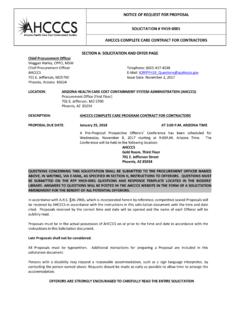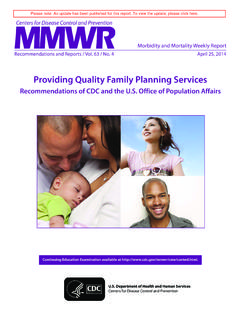Transcription of HC 2004 - Christian Lawyers' Association v Minister of Health
1 Christian Lawyers' Association v National Minister of Health and Others Case No: 7728/2000. High Court, Transvaal Provincial Division 2004 (10) BCLR 1086 (T). JUDGMENT DATE: 24/05/2004. Mojapelo J. Introduction This is a judgment on an exception filed by the defendants against the plaintiff's particulars of claim on the ground that the particulars of claim do not disclose a cause of action. The plaintiff instituted an action in which it seeks an order declaring sections 5(2) and 5(3) read with, the definition of "woman" in sections 1 and 5(1) of the Choice on termination of pregnancy Act 92 of 1996 ("the Act") to be unconstitutional and an order striking down sections 5(2) and 5(3) and the definition of "woman" in section 1 of the Act. The essence of the claim and the exception The provisions of the Act that the plaintiff's claim is directed at are the provisions that allow women under the age of 18. years to choose to have their [*12] pregnancies terminated without (a) the consent of the parents or guardians, (b).
2 Consulting the parents or guardians, (c) first undergoing counselling, and (d) reflecting on their decision or decisions for a prescribed period. The measures in (a) to (d) are for the sake of convenience collectively hereafter referred to as parental consent or control. It is the plaintiff's case in essence that young women or girls below that age are not capable on their own, that is, without parental consent or control to take an informed decision whether or not to have a termination of pregnancy which serves their best interests. The plaintiff structured its particulars of claim into five identifiable parts: an introduction (paragraphs 1 to 22), claim A. (paragraphs 23 to 25), claim B (paragraphs 26 to 28), claim B (paragraphs 29 to 32) and conclusion (paragraph 33 to 35): all in support of the same prayers set out above (prayers 1 to 3). In order to succeed with its claim the plaintiff has to establish that the relevant provisions of the Choice Act are in conflict with and affront the specified sections of the Constitution of the Republic of South Africa Act 108 of 1996 ("the Constitution").
3 [*13]. In the particulars of claim the plaintiff makes a number of allegations in paragraphs 5 to 18 about inter alia the effect of the termination of pregnancy on a girl, the vulnerability of the girl when making such decisions, certain changes in the developmental stages of a girl and characteristics of such changes. In paragraphs 19 to 20 the plaintiff makes the following allegations which are critical for its claim- " paragraphs 16 to 18 above, a girl is not in a position to make an informed decision about whether or not to have an abortion which serves her best interests without the assistance and/or guidance of her parents/guardian and/or counsellor.". paragraphs l6 to 18 above, a girl: unable fully to appreciate the need for and value of parental care and support, and the assistance and/or guidance of a counsellor;. not capable of giving consent as required in section 5(1) of the Act.". Those introductory paragraphs of the plaintiff's particulars of claim then conclude as follows in paragraph 21: "21 Given paragraphs 10 to 20 above a pregnant girl requires special protection by the State, inter alia by ensuring that when enacting legislation [*14] which affects her, she is not deprived in any way of the support, guidance and care of her parents/guardian and/or counsellor.
4 ". It is on the basis of these conclusionary factual allegations that the plaintiff concludes in its particulars of claim in paragraphs 23 to 35 that the Act is in conflict with the Constitution in the specific respects specified in claims A, B and C. The essence of the various causes of action relied upon by the plaintiff is that the provisions under attack are unconstitutional because they permit a woman under the age of 18 years to choose to have her pregnancy terminated without parental consent or control. The defendants filed an exception to these particulars of claim, alternatively, to claims A, B and C, on the ground that they do not disclose a cause of action for the relief that the plaintiff seeks. In particular, the defendants except to the plaintiffs claims on the ground that the conclusions in law in regard to claims A, B and C and the overall conclusions that flow therefrom are not supported by the facts on which they are based.
5 The amicus curiae filed a brief which supports the position of the defendants. The provisions of the Act and the [*15] Constitution It is necessary when considering the issues raised to bear in mind the statutory provisions that came under attack in this case. The relevant sections of the Act provide as follows: In section 1 of the Act the word "woman" is defined as follows: "'woman' means any female person of any age.". Subsections 5(1), 5(2) and 5(3) provide as follows: "(1)Subject to the provisions of subsections (4) and (5) the termination of a pregnancy may only take place with the informed consent of the pregnant woman. (2)Notwithstanding any other law or the common law, but subject to the provisions of subsections (4) and (5), no consent other than that of the pregnant woman shall be required for the termination of a pregnancy . (3)In the case of a pregnant minor, a medical practitioner or a registered midwife, as the case may be, shall advice such minor to consult with her parents, guardian, family members or friends before the pregnancy is terminated: provided that the termination of the pregnancy shall not be denied because such minor chooses not to consult them.
6 ". Subsections (4) and (5) deal with exceptional cases which arc not relevant for the present purposes. The [*16]. subsections deal with situations such as the case of a woman who is severely mentally disabled, is in a state of continuous unconsciousness or where the medical practitioners involved are of the opinion that continued pregnancy would pose the risk of injuries to the woman's physical or mental Health , where there exists substantial risk that the foetus would suffer from severe physical or mental abnormality, where continued pregnancy would endanger the woman's life, result in severe malformation of the foetus or pose a risk of injuries to the foetus. The provisions of both subsections are therefore not in issue in the present case. The constitutional pegs on which the plaintiff hangs its case are the following sections 28(1)(b), 28(1)(d) and 9(1) read with section 7(1) of the Constitution of the Republic of South Africa Act 108 of 1996 ("the Constitution").
7 The relevant sections of the Constitution read as follows: Section 28(1)(b): "Every child has the right to family care or parent care. Section 28(1)(d): "Everyone has the right to be protected from maltreatment, neglect, abuse or degradation.". Section 28(2): "A child's best interests are of paramount importance in [*17] every matter concerning the child.". Section 9(1): "Everyone is equal before the law and has the right to equal protection and benefit of the law.". Section 7(1): "This Bill of Rights is a cornerstone of democracy in South Africa. It enshrines the rights of all people in our country and affirms the democratic values of human dignity, equality and freedom.". The plaintiff structured its attack on the constitutionality into three separate claims relying on different sections of the Constitution as follows: claim A - section 28(1)(b), 28(1)(d); claim B - section 28(2) and claim C - section 9(1).
8 The structure or scheme of the Choice Act It is necessary (when examining the plaintiff's claim in order to determine whether the exception is sustainable or not) to understand and bear in mind the structure or scheme of the Act. The Act regulates the termination of pregnancy of women. The principal rules by which it does so are the following: (a)The termination of a pregnancy may only be done with the informed consent of the woman. (b)If she gives her informed consent to the termination of her pregnancy , no other consent is required (section 5(1) and 5(2)). (c)During the first [*18] twelve weeks of pregnancy , no more is required than the woman's informed consent. (d)Thereafter a pregnancy may only be terminated in certain circumstances (section 2). (e)The termination may only be performed by a medical practitioner or, if it is performed during the first twelve weeks, by a registered midwife who has completed a prescribed training course (section 2(2)).
9 (f)The termination may only be performed at a facility designated by the Minister (section 3(1)). (g)A pregnancy may not be terminated unless two medical practitioners or a medical practitioner and a registered midwife who has completed a prescribed course consent thereto (proviso to section 5). The Act also has the following ancillary provisions regulating the termination of the pregnancy : The State is obliged to promote the provision of counselling to women before and after the termination of pregnancy . The counselling is, however, not mandatory or directive (section 4). Young women (below the age of 18 years) are encouraged to consult with their parents, guardians, family members or friends before termination of their pregnancy . The medical practitioner or midwife, who performs the termination , must [*19] advise them to do so before their pregnancy is terminated. The actual final decision is, however, left to them to decide whether or not to consult with their parents, guardians, family members and/or friends (section 5(3)).
10 The medical practitioner or midwife, who performs a termination , must inform the woman of their rights under the Act (section 6). It is therefore not as if the Legislature left the termination of pregnancy totally unregulated. The cornerstone of the regulation of the termination of pregnancy of a girl and indeed of any woman under the Act is the requirement of her "informed consent", No woman, regardless of her age, may have her pregnancy terminated unless she is capable of giving her informed consent to the termination and in fact does so. It is therefore necessary to consider the juridical meaning and effect of the requirement of informed consent. The requirement of "informed consent" at law The Act does not define or elaborate on what is meant by the requirement of "informed consent" for the termination of pregnancy . The concept is, however, not alien to our common law. It forms the basis of the doctrine of volenti non fit injuria that justifies [*20] conduct that would otherwise have constituted a delict or crime if it took place without the victim's informed consent.






